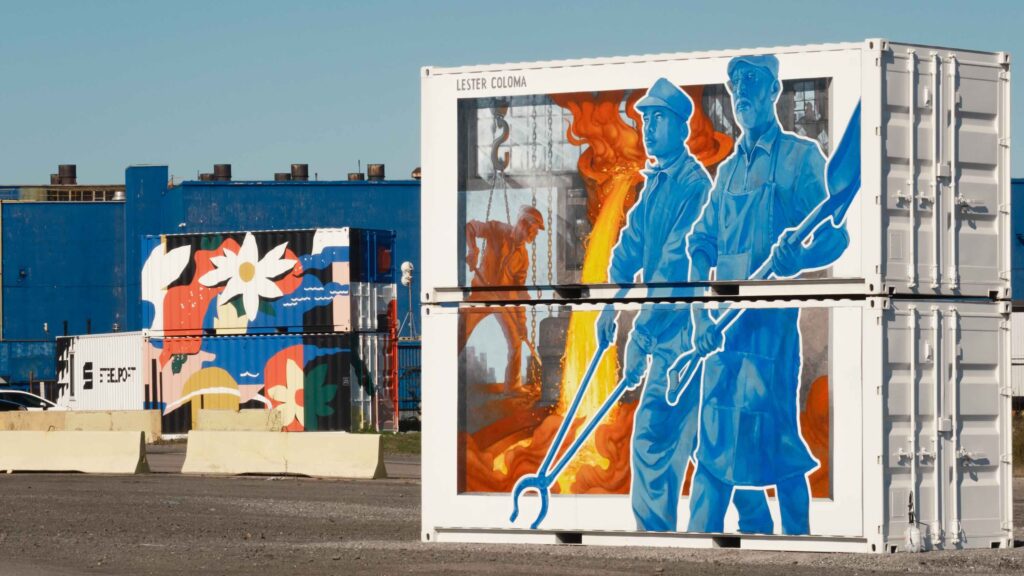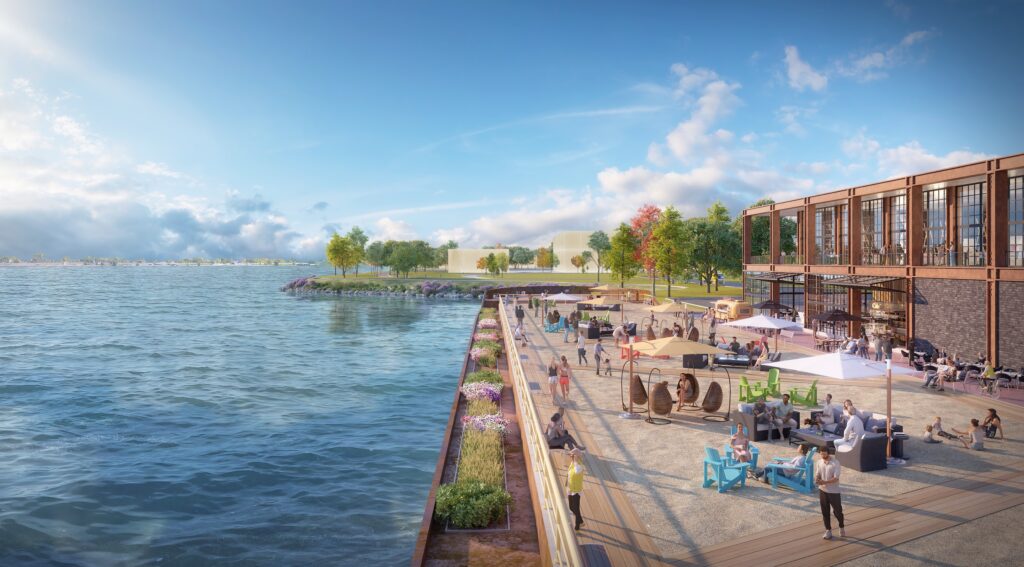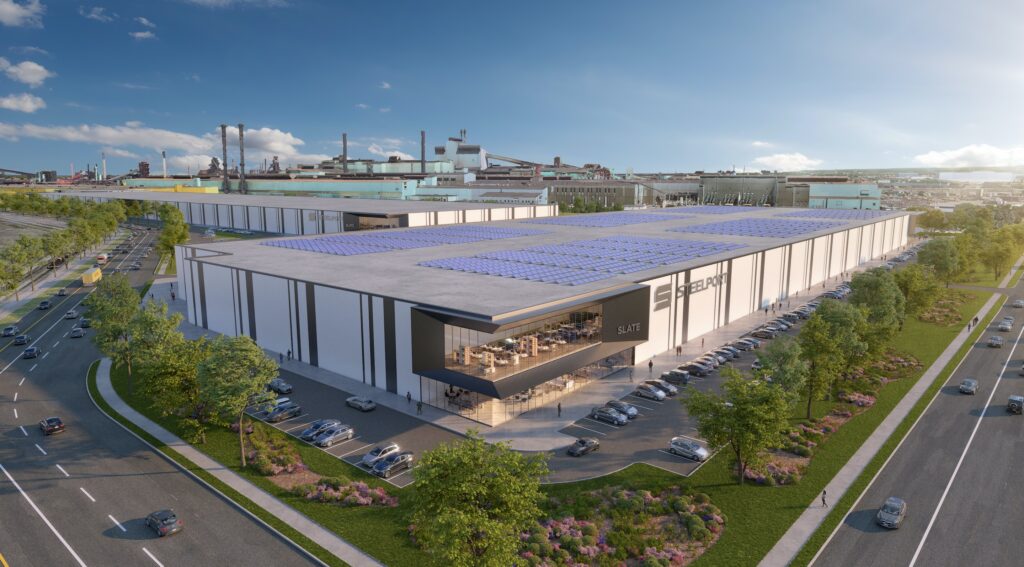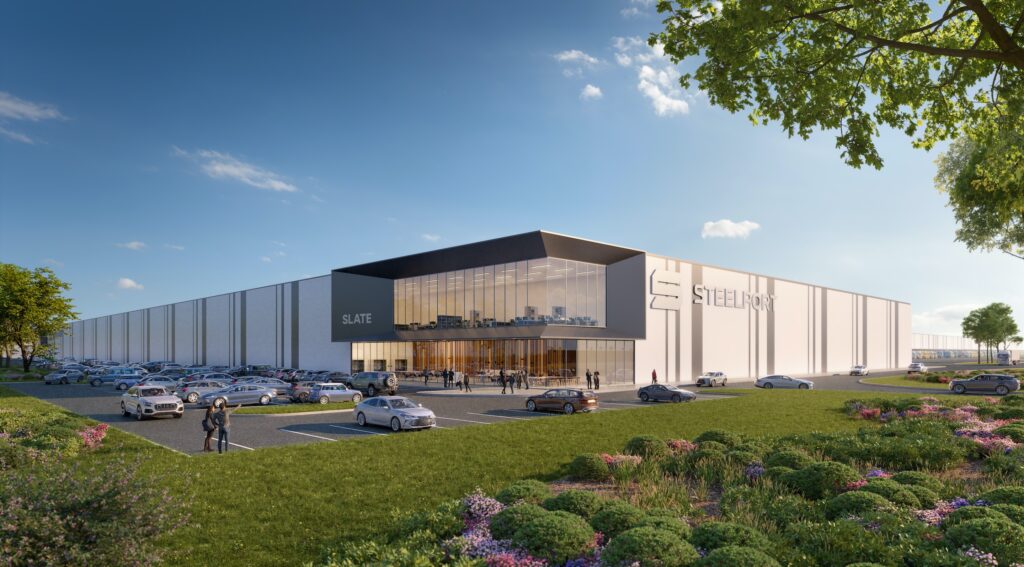Art comes to Hamilton steel lands

City muralists commissioned to paint stacked sea containers that are a first step in realizing a new vision for former Stelco property.
On an industrial site closed to the public for more than a century, there is the first stroke of a vision to create a master planned employment park that will welcome Hamiltonians to that part of the waterfront again.
Slate Asset Management, which owns the former Stelco lands that are now called Steelport, commissioned Hamilton artists to paint murals on two sets of stacked shipping containers beside a mobile on-site office for the project team that sits right along Industrial Drive near Depew Street.
Hamilton artists, Ver Sands (Jacqui Oakley and Jamie Lawson) and Lester Coloma, were chosen for their artistic styles, experience, ties to Hamilton and knowledge of the city’s history. They were tasked with capturing the legacy of the Steelport site, the vision for its future, and Hamilton’s spirit.
“These murals created by local Hamilton artists are a first, small step toward transforming Steelport into a vibrant hub where people want to work and spend time,” says Steven Dejonckheere, senior vice president of development at Slate and project lead for Steelport.
“We think it’s important to acknowledge and celebrate the history, but making it very clear that we’re proposing something very new and different here. And so I think that was the message to all of the artists.”
Ver Sands created a mural that incorporated industrial images of chimneys and factory buildings morphing into natural elements.
“Steelport gave us the freedom to create something that will fit the area today and in the future. Working at this scale was a fun challenge, and the locale became a crucial source of inspiration as we painted,” Oakley and Lawson said in a statement.
“Our hope is that this artwork provides some excitement and joy for people who come across it, particularly in the early stages of the Steelport project, when the contrast between the containers and their surroundings is at its height.”
In his mural, Coloma depicts the working history of Hamilton’s industrial area, with two workers in the foreground representing thousands who toiled at the site.
“The inspiration for my mural design stems from Slate’s commitment to honour the historic Stelco lands by integrating past industrial buildings, structures, and artifacts into its Steelport development,” Coloma said in a statement.
“My concept features a scene from the steelmaking process, prominently showcasing the labourers who contributed to Hamilton’s steel town legacy.”

Slate’s vision for Steelport includes about 11 million square feet of new buildings geared toward traditional and advanced manufacturing, logistics and transportation operations, production and innovation hubs, energy and tech companies, creative industries, and professional services. The project also includes retail and restaurant nodes, public spaces that support art, entertainment and heritage industrial elements from the site’s steelmaking history, as well as trails, a park and a waterfront promenade that will serve both those who work on-site and city residents.
This is an enormous site that has played a critical role in the social and economic history of Hamilton. At 800 acres, it’s roughly the size of New York’s Central Park and would take up the area between the Gardiner Expressway to Dundas and Spadina to Sherbourne if plunked down in Toronto.
Slate, a Toronto-based private equity firm, bought the lands in June 2022 for $518 million, leasing back 75 acres to Stelco to continue with its coke battery and cold-rolled steel operations.
RELATED: Slate unveils plans for massive Hamilton projects
“Slate always likes to include public art in its projects,” says Dejonckheere. “We've always valued that both to support the local community but also to help with placemaking. So we are looking for opportunities like that.”
One of the objectives at the early stage of the Hamilton project is to build awareness.
“We want to ensure that people understand what we're doing on the site, and to try to get people excited and supportive of that,” he says.
“We thought (the murals) would be a really great dynamic way to get a bit of interest in what we are doing, while being able to support some local artists. And I think one of the key advantages of it is that they'll be mobile, because as we start to develop the site by phases, we can rearrange these and move them around, and maybe we can supplement and start to add to them and start to create a larger program around that.”
Dejonckheere says Slate is now going through the plan of subdivision process with the city, which will set out the new road and block network for the site. It’s hoped that approval will come early next year.
The buildout of the project will happen in phases, taking up to a decade, he says.
Phase 1 will begin with the extension of Depew Street about halfway into the site, which will open about 100 acres. The hope is that road construction can begin next year.
Steelport is in talks with a number of potential tenants and development partners, says Dejonckheere. Many are expected to be attracted to the site’s access to rail, road and a deep port.
“Hopefully, we'll be able to make some announcements on who a first tenant will be in the near future. We want to be quite selective and pick the right type of first tenant, because we want to make sure they'll set the tone and the precedent for the rest of the development. So we are all thinking about that as we look at the opportunities in front of us.”
Slate has said, that based on a 2022 study from Ernst and Young, at full buildout Steelport could create up to 23,000 new jobs in the GTHA and inject $3.8 billion into Ontario’s economy.
Photos: Slate Asset Management















